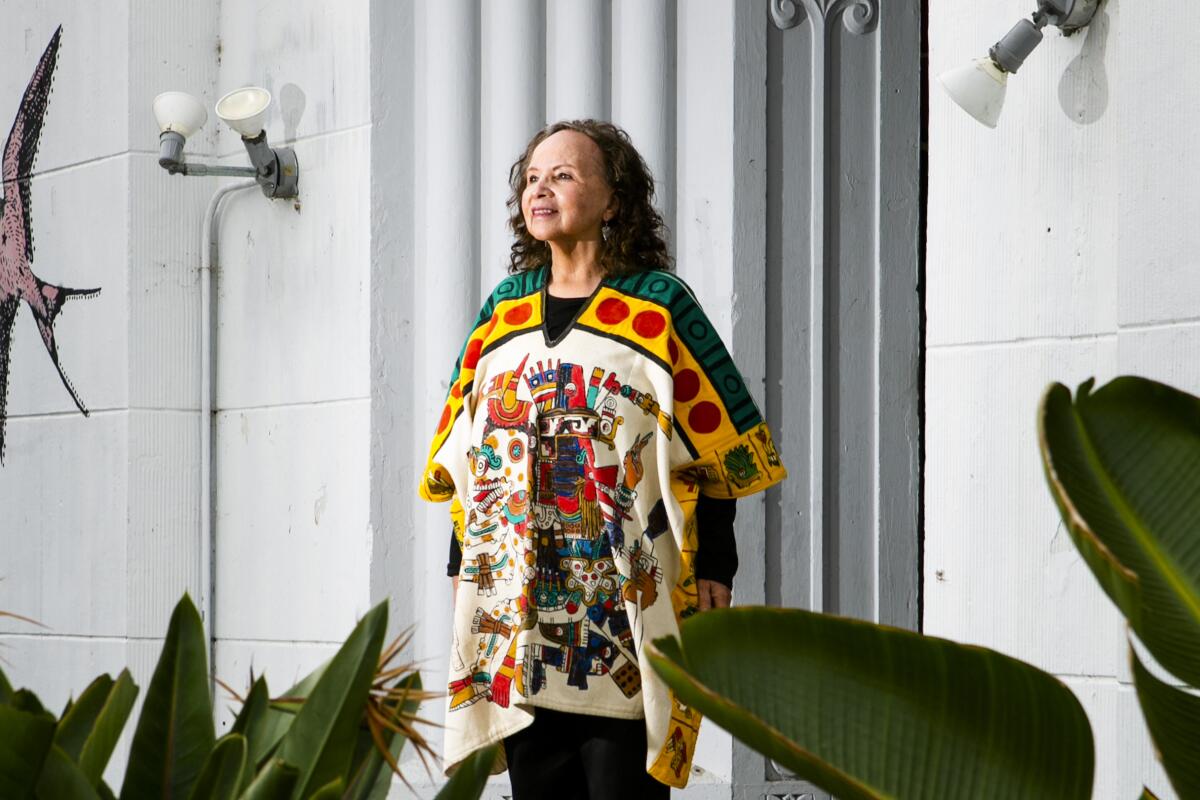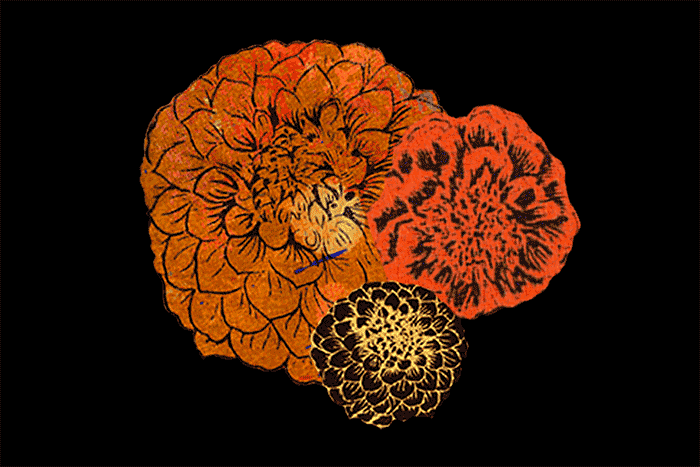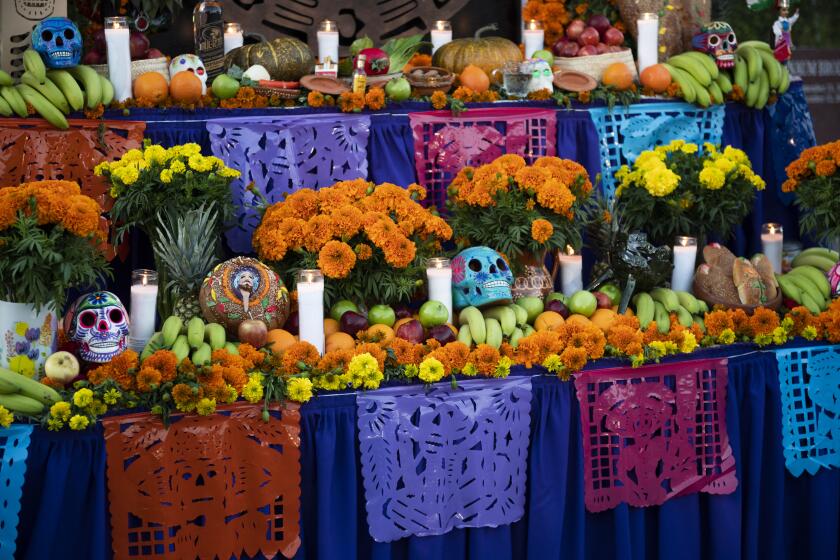Tamales, salt and bread ‘bones’: How foods are central to Day of the Dead

- Share via
Are these really supposed to be bones?
The thought crossed my mind looking at loaves of pan de muerto, the “bread of the dead” central to Día de los Muertos, or Day of the Dead. Though the bread takes many forms, one ubiquitous design features a round loaf topped by intersecting strips of dough forming a cross.
I had read that the strips represent bones; that explains their often-knobby look. But I’d also heard they signify the four directions. Another interpretation holds that the cross is, well, a Christian cross.
So which is correct? The answers say much about the nature and origins of this most Mexican of holidays, an observance that blends pre-Hispanic culture with beliefs brought by the Spaniards when they conquered Mexico half a millennium ago. They also show how food — whether pan de muerto, tamales, tequila or maybe even a can of Sprite — plays a central role in welcoming the spirits said to return to earth the first two days of November.
I must confess my family never observed Día de los Muertos. Though three of my grandparents were born in Mexico and Spanish was the first language of my U.S.-born parents, the holiday didn’t take hold here like traditions surrounding Christmas or New Year’s. Our family was too citified to appreciate the Indigenous elements of the holiday.
Inspired by those found at Grand Park and the Hollywood Forever Cemetery around this time of the year, we’ve created our own communal digital altar.
But since last year, after losing my parents and older brother in just 10 months, I decided to get a bit closer to this tradition and understand it — through its foods.
Though some Día de los Muertos observances in Mexico take place from mid-October to mid-November, generally the holiday is marked on Nov. 1 and 2. Families erect ofrendas, displays decorated with flowers, candles, food and photographs of the deceased.
Ofrenda is often translated as “altar,” but that misses a nuance. After all, “altar” in Spanish is “altar.”
“I use ofrenda rather than altar because altar has a religious connotation,” said Martha Ramírez-Oropeza, a professor with the Chicana/o and Central American studies department at UCLA.

“Literally, ‘ofrenda’ means ‘offering,’ which is to offer something very special of yourself — your work, your sacrifice, your heritage — to others. And in this case, it is to those who have died,” she said.
An expert on Día de los Muertos who spent years studying practices surrounding the holiday in Mexico, Ramírez-Oropeza is also a muralist, actress, researcher and artist in residence at SPARC, the Social and Public Art Resource Center in Venice. For years she’s led the center’s annual Día de los Muertos celebration.
To understand the Day of the Dead, Ramírez-Oropeza told me, you must appreciate two concepts. The first is syncretism, the merging of two traditions into a new one.
The second is what pre-Hispanic peoples called ixiptlah, a Nahuatl word meaning an image acting as a substitute of something or someone.
This fits neatly with the omnipresent concept of duality in pre-Hispanic thought. Life and death, for example, were seen as existing comfortably side by side and not in opposition. More yin and yang than before and after. “We can’t be alive if we’re not dying. We’re dying and we’re living at the same time,” Ramírez-Oropeza said.
This brings us to how traditions combined for Day of the Dead. Consider the timing. One of the two calendars Mesoamericans used consisted of 18 months of 20 days; certain months featured remembrances of the dead, and two of those months fell around October and November. The Roman Catholic Church observes All Saints’ Day on Nov. 1.
The use of foods to honor and welcome the dead has roots that stretch back to one of the Aztecs’ creation myths, Ramírez-Oropeza said. She recounted the story of how the god Quetzalcoatl and his twin, Xolotl, journey to Mictlan, the land of the dead, to retrieve bones that were used to create human beings.
A goddess helps in the creation of humans and does so with a cooking implement. An image from an Aztec-era codex that Ramírez-Oropeza showed me depicts the goddess Quilaztli or Cihuacoatl pulverizing the bones on a metate, a slanted stone grinding tool found in Mexico to this day, usually used for breaking down corn.
“So when we’re cooking — heating a tortilla or whatever — we’re doing that too symbolically. We are re-creating ourselves,” Ramírez-Oropeza said.
The strips on the pan de muerto indeed represent bones, Ramírez-Oropeza told me. What’s more, a round bit of dough often included where the strips intersect represents a skull.
And the four directions and Christian cross? The strips can represent those too. In fact, some people might view the strips as bones, directions and the cross all at once and comfortably so, a multicultural interpretation colonizing Spanish priests would have declared heathen.
“Remember, everything is mixed together,” she said.
While the round loaves of pan de muerto are symbolic, other designs are more literal. Sometimes the bread takes a body shape, with straight legs and folded arms. In Ocotepec, a Guerrero state village where Ramírez-Oropeza spent years conducting research, the pan is more symbolic, with oval-like bodies and just hints of legs and arms on the chest.
The bread used in parts of Oaxaca is sometimes more elaborate, with glazing or frosting creating intricate designs or the faces of saints.
Día de los Muertos (Day of the Dead) is Nov. 1 and 2, 2021. Here’s what goes into building an ofrenda, or altar, for a deceased loved one.
Some pan is decorated with pink sugar, a color scheme with ancient roots. Pre-Hispanic people made a ceremonial bread with amaranth, which produces flowers in a rich, dusky maroon. The Spaniards banned the plant for a time because of supposed links to human sacrifice.
The pink appears on various forms of pan de muerto. In Guanajuato state, it shows up as a dollop of color on body-shaped loaves covered in white frosting. Then there’s Mizquic bread — the name comes from Mitclan, the land of the dead. These breads aren’t loaves but circles of dough — imagine little steering wheels — and bright pink.
No matter the shape or color, the pan de muerto serves as both an offering on the ofrenda and as a nice snack. (You’ll find pan de muerto at panaderías or Latino supermarkets.) Ramírez-Oropeza showed me photos of what she called the “weirdest and most contemporary” takes on the pan, the loaf serving as sandwich bread with fillings of chilaquiles or roast pork. Even cream cheese.
On the ofrenda, the pan and other foodstuffs (mole, tamales, fruits, nuts, whatever) represent the earth. Among Nahua people in Puebla, tamales play a vital role, serving as a host for the visiting spirits. The masa is the body, the filling the bodily liquids and the cornhusk wrapper, or hoja, the coffin.
Along with earth, the other three elements of water, fire and air are represented on the ofrenda. Water is displayed, but you’re free to include other beverages the deceased enjoyed — tequila, chocolate or that Sprite. (Any ofrenda erected for me, I’m sorry to say, will likely include English breakfast tea or Diet Coke.) Fire is represented by candles and air by the colorful papel picado, which moves in the wind.
Another key element for any ofrenda is salt. It gives the spirits strength, Ramírez-Oropeza said, to journey to the land of the living.
I had long thought of Día de los Muertos as an intimate holiday centered on family. And it is. But Ramírez-Oropeza revealed a lovely side of the holiday I never knew: In one tradition, you make tamales but don’t place them on your ofrenda. You give them to someone else for their ofrenda. And someone gives you tamales for yours.
And so, individually but also as a community, with food, we remember those who have gone before us.
More to Read
Eat your way across L.A.
Get our weekly Tasting Notes newsletter for reviews, news and more.
You may occasionally receive promotional content from the Los Angeles Times.














